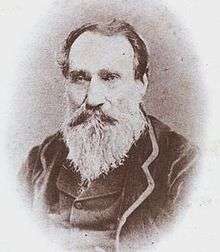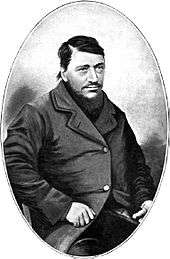Transvaal Civil War
| Transvaal Civil War | |||||||
|---|---|---|---|---|---|---|---|
| Part of the | |||||||
| |||||||
| Belligerents | |||||||
|
|
| ||||||
| Commanders and leaders | |||||||
|
|
| ||||||


The Transvaal Civil War was a series of skirmishes in the South African Republic, or Transvaal—now part of South Africa—in the early 1860s. It began after the British government had recognized trekkers living in the Transvaal as independent in 1854.[1] The Boers divided into numerous political factions. It only ended in 1864 when an armistice treaty was signed under a Karee tree south of the site of the later town of Brits.[2]
History
In late 1859 Pretorius was invited to stand for President in the Orange Free State, where many burghers now favoured union, partly as a means to overcome the Basotho. The Transvaal constitution he had just enacted made it illegal to simultaneously hold office abroad, but nevertheless he readily did so and won. The Transvaal volksraad attempted to side-step the constitutional problems surrounding this by granting Pretorius half a year's leave, hoping a solution might come about during this time, and the President duly left for Bloemfontein, appointing Johannes Hermanus Grobler to be Acting President in his absence. Pretorius was sworn in as President of the Free State on 8 February 1860; he sent a deputation to Pretoria to negotiate union the next day.[3]
Kruger and others in the Transvaal government disliked Pretorius's unconstitutional dual presidency, and worried that Britain might declare the Sand River and Orange River Conventions void if the republics joined.[3] Pretorius was told by the Transvaal volksraad on 10 September 1860 to choose between his two posts—to the surprise of both supporters and detractors he resigned as President of the Transvaal and continued in the Free State.[3] After Schoeman unsuccessfully attempted to forcibly supplant Grobler as Acting President, Kruger persuaded him to submit to a volksraad hearing, where Schoeman was censured and relieved of his post. Willem Cornelis Janse van Rensburg was appointed Acting President while a new election was organised for October 1862. Having returned home, Kruger was surprised to receive a message urgently requesting his presence in the capital, the volksraad having recommended him as a suitable candidate; he replied that he was pleased to be summoned but his membership in the Dopper Church meant he could not enter politics. Van Rensburg promptly had legislation passed to give equal political rights to members of all Reformed denominations.[4]
Schoeman mustered a commando at Potchefstroom, but was routed by Kruger on the night of 9 October 1862. After Schoeman returned with a larger force Kruger and Pretorius held negotiations where it was agreed to hold a special court on the disturbances in January 1863, and soon thereafter fresh elections for President and Commandant-General.[5] Schoeman was found guilty of rebellion against the state and banished. In May the election results were announced—Van Rensburg became President, with Kruger as Commandant-General. Both expressed disappointment at the low turnout and resolved to hold another set of elections. Van Rensburg's opponent this time was Pretorius, who had resigned his office in the Orange Free State and returned to the Transvaal. Turnout was higher and on 12 October the volksraad announced another Van Rensburg victory. Kruger was returned as Commandant-General with a large majority.[6] The civil war ended with Kruger's victory over Jan Viljoen's commando, raised in support of Pretorius and Schoeman, at the Crocodile River on 5 January 1864. Elections were held yet again, and this time Pretorius defeated Van Rensburg. Kruger was re-elected as Commandant-General with over two-thirds of the vote.[7]
The civil war had led to an economic collapse in the Transvaal, weakening the government's ability to back up its professed authority and sovereignty over the local chiefdoms,[8] though Lydenburg and Utrecht did now accept the central administration.[9] By 1865 tensions had risen with the Zulus to the east and war had broken out again between the Orange Free State and the Basotho. Pretorius and Kruger led a commando of about 1,000 men south to help the Free State. The Basotho were defeated and Moshoeshoe ceded some of his territory, but President Johannes Brand of the Free State decided not to give any of the conquered land to the Transvaal burghers. The Transvaal men were scandalised and returned home en masse, despite Kruger's attempts to maintain discipline.[10] The following February, after a meeting of the executive council in Potchefstroom, Kruger capsized his cart during the journey home and broke his left leg. On one leg he righted the cart and continued the rest of the way. This injury incapacitated him for the next nine months, and his left leg was thereafter slightly shorter than his right.[10]
In 1867, Pretoria sent Kruger to restore law and order in Zoutpansberg. He had around 500 men but very low reserves of ammunition, and discipline in the ranks was poor. On reaching Schoemansdal, which was under threat by the chief Katlakter, Kruger and his officers resolved that holding the town was impossible and ordered a general evacuation, following which Katlakter razed the town. The loss of Schoemansdal, once a prosperous settlement by Boer standards, was considered a great humiliation by many burghers. The Transvaal government formally exonerated Kruger over the matter, ruling that he had been forced to evacuate Schoemansdal by factors beyond his control, but some still argued that he had given the town up too readily.[11] Peace returned to Zoutpansberg in 1869, following the intervention of the republic's Swazi allies.[8]
Pretorius stepped down as President in November 1871. In the 1872 election Kruger's preferred candidate, William Robinson, was decisively defeated by the Reverend Thomas François Burgers, a church minister from the Cape who was noted for his eloquent preaching but controversial for some because of his liberal interpretation of the scriptures. He did not believe in the Devil, for example.[12][n 1] Kruger publicly accepted Burgers's election, announcing at his inauguration that "as a good republican" he submitted to the vote of the majority, but he had grave personal reservations regarding the new President.[12] He particularly disliked Burgers's new education law, which restricted children's religious instruction to outside school hours—in Kruger's view an affront to God.[13] This, coupled with the sickness of Gezina and their children with malaria, caused Kruger to lose interest in his office. In May 1873 he requested an honourable discharge from his post, which Burgers promptly granted. The office of Commandant-General was abolished the following week. Kruger moved his main residence to Boekenhoutfontein, near Rustenburg, and for a time absented himself from public affairs.[12][n 2]
See also
- First Boer War, 1880–81
- Second Boer War, 1899–1902
References
- ↑ Some information
- ↑ ‘Stormvoël van die Noorde’ by O JO Ferreira; ‘Jan Viljoen – ‘n Transvaalse Wesgrenspionier’ (unpublished MA dissertation); documents and notes from the Jack Seale collection.
- 1 2 3 Meintjes 1974, pp. 49–51.
- ↑ Meintjes 1974, pp. 52–53.
- ↑ Meintjes 1974, pp. 54–56.
- ↑ Meintjes 1974, pp. 56–57.
- ↑ Meintjes 1974, pp. 58–60.
- 1 2 3 Davenport 2004.
- ↑ Meintjes 1974, p. 44.
- 1 2 Meintjes 1974, pp. 61–63.
- ↑ Meintjes 1974, pp. 64–65.
- 1 2 3 Meintjes 1974, pp. 68–71.
- 1 2 Meintjes 1974, pp. 73–74.
- ↑ The Doppers despised Burgers, denouncing him as "Godless"; some even called him the Antichrist.[13]
- ↑ Kruger had owned Boekenhoutfontein since 1860. He retained Waterkloof as well; he would own both properties for the rest of his life, while acquiring and selling many others.[8]